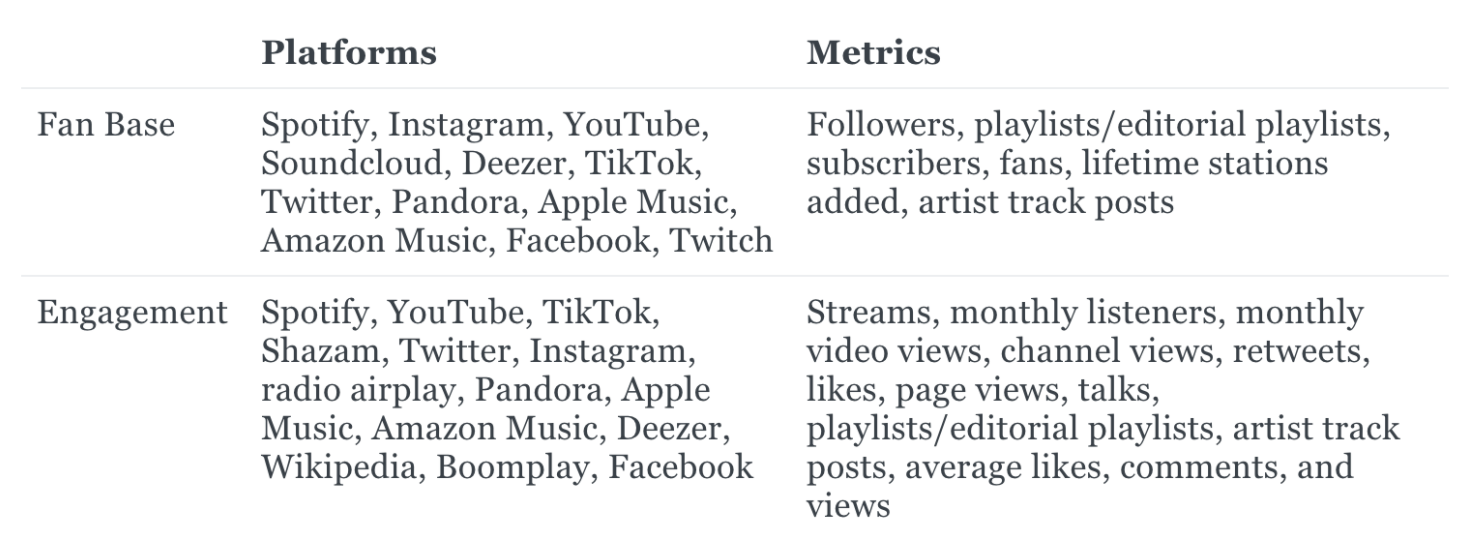Inside Chartmetric’s new global digital artist ranking
In an industry where popularity data and ranking provides critical insight, being able to effectively track performance is key. For this reason, Chartmetric has updated their Cross-Platform Performance ranking to provide more accurate information.
Guest post by Remi Choi of Chartmetric

In an industry where popularity and insights are assessed by performance on a number of platforms, a ranking that encapsulates these various platforms is particularly useful. By condensing the different numbers into a single metric, users can quickly see a data-based tiering of top artists and are also alerted to any significant movement of individual metrics. We initially addressed this challenge with our Cross-Platform Performance (CPP) ranking. As our database has improved over the past couple of years with updates in coverage both of and within platforms, we decided to update CPP to reflect these developments.
Three main changes were made:
- Platform coverage increased from eight to 16 platforms being factored into CPP.
- CPP range increased from Top 500K to Top 1M artists.
- Fan Base and Engagement categories were added as separate ranks to further break down an artist’s ranking.
So, how do these changes affect an artist’s CPP, or global digital artist ranking?
Arguably the biggest change from the previous CPP system is the addition of data from eight music and social media platforms including Pandora, Amazon Music, radio airplay, Shazam, Boomplay, TikTok, and Twitch, as well as an update in playlist data from Spotify, YouTube, Deezer, and Amazon Music.
Below, see the full catalog of platforms and metrics for which data are included.

Including metrics from a wider range of services has allowed us to better reflect the growth of music consumption globally. Over recent years, growth rates for music consumption in what were once termed “emerging markets” have outpaced those in traditional markets, and music tastes and trends in these markets are now also having a global impact. For instance, at the time of writing, Omah Lay, an artist with a Top 10 Boomplay rank, went from No. 4,460 with the former CPP to No. 1,952 with the new CPP — a jump of 2.5K positions. When the track Pretty Girl – Cheat Codes X CADE Remix trended on TikTok with 3M+ posts using this sound, artists Maggie Lindemann and CADE both rose to the Top 400 artists, while the former CPP placed them only in the Top 3K.
The definitions of the previous iteration’s Stage and Followers have also been updated to categorize metrics more explicitly. We’ve renamed these CPP factors Engagement and Fan Base, respectively. Fan Base scores represent an artist’s long-term accumulated fanbase and thus are formed from cumulative, lifetime metrics (e.g., Spotify followers, Instagram followers). Engagement scores reflect the artist’s current relevance and activity and are calculated from metrics with more immediate changes. Metrics used to calculate Engagement are composed of more sensitive statistics (e.g., YouTube channel views, playlist count difference, Wikipedia page views). As artists separate into those with established success (high Fan Base) and those with viral popularity (high Engagement), tracking these differences is increasingly valuable. Considering these scores and ranks separately allows for a more direct look into the factors that are affecting an artist’s overall global digital artist ranking. Fan Base measures long-term success, favoring artists with a strong and loyal fanbase, regardless of recency. Meanwhile, Engagement measures virality, favoring hot trending artists based solely on recent performance.
Below, check out the Top 50 artists broken down by CPP rank, Engagement rank, Fan Base rank, and select metrics on streaming and social media platforms.
Finally, as our artist database has grown to include 3M+ artists, we expanded the CPP ranking from the Top 500K to the Top 1M. Upon backfilling ranks using the new CPP, 30K+ formerly unranked artists peaked in the Top 10K. Increasing the rank threshold to 1M will hopefully also allow for better discovery of potential emerging artists earlier in their journey.
As our database grows and different music and social media platforms shift in popularity with artists and their audiences, CPP is also prone to further changes to reflect such movement. These updates are key in our goal to maintain accurate and reliable metrics as well as keep users up to date with the constant movement of data in the music industry.
Join the Chartmetric community by subscribing to How Music Charts below.